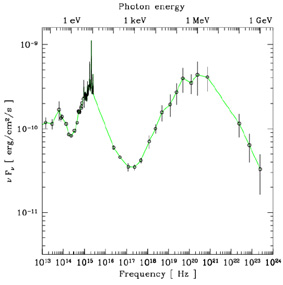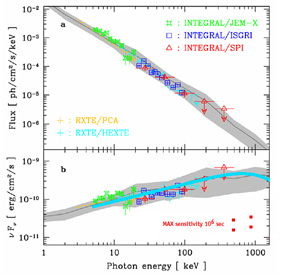 |
| la science |
| les supernovae |
| les novae |
| les objects compacts |
| les sursauts solaires |
| retour |
The MAX contribution to the study of microquasars : Millimetre observations of 1E 1740.7-2942 have revealed that the source coincides with a dense molecular cloud (Mirabel et al. 1991), even if there is still a 7% chance superposition probability. It was then suggested by Ramaty et al. (1992) and Laurent & Paul (1994) that a fraction of the positrons, released impulsively from the compact source, has streamed up to the molecular cloud against which the source is projected. The positrons can then slow down and annihilate in such a cold medium thus emitting a narrow 511 keV line. For reasonable values of the system parameters and luminosity, Laurent & Paul (1994) have shown that the emitted 511 keV flux from 1E 1740.7-2942 could be sufficient enough to account for a large fraction of the detected 511 keV flux from the galactic centre region. With its high sensitivity to narrow lines, and its in spatial resolution, MAX will be well suited to localise the electron-positron annihilation signature from galactic microquasars, and to map the spatial extension of the emission along the jets.
The correlation between a microquasar and a molecular cloud has not been yet observed for the other specimens. However, evidences of jet deceleration have been demonstrated from the radio observations of XTE J1748-288 (Hjellming & Mioduszewski 1998). It could then be reasonably postulated, that the jets should decelerate somewhere and trigger 511 keV narrow-line sources, which should be luminous enough to be clearly detected by MAX.
Black hole X-ray novae : The number of galactic black hole candidates
has dramatically increased during the last years due to the availability
of all sky monitors and the discovery of the soft X-ray transients. These
objects are a class of low-mass X-ray binaries with a K or M-type companion
star that are very similar to dwarf novae but that contain a black hole
(BH) instead of a WD as compact object. One of the most intriguing aspects
of such objects is the discovery of strong Li 6707 Å absorption lines
in the companion star. A typical example is V404 Cyg (Martin et al. 1992).
Since Li is destroyed during normal stellar evolution, it is clear that
its presence in the star must be related with the process of formation
of the BH and/or of the accretion disk around it. There are, in principle,
three possibilities:
- Li was created by neutrino spallation during the gravitational collapse
to a BH.
- Li was created from the decay of 7Be by the Cameron-Fowler mechanism
operating on the accretion disk (something similar to what happens in novae
and AGB stars); in such a case, a line corresponding to 7Be is expected.
- Li was created by spallation of p and a over C,N,O; in such a case,
a line corresponding to 7Be is also expected plus those of desexcitation
of 12C and 16O.
What it is interesting enough is the detection by the SIGMA telescope
aboard GRANAT of a 476 keV line in Nova Muscae 1991 (Goldwurm et al. 1992).
This line was interpreted in terms of a redshifted annihilation line, but
it could also be interpreted as the 478 keV deexcitaiton line of 7Li. This
line was observed for only 12 hours. Its detection and analysis in another
BH X-ray nova outburst could provide a lot of insight about this problem.
In any case, even if this line is caused by positron annihilation, the
observation of such events with MAX should have the highest interest. The
flux in the 430-510 band was observed to be 10-3 cm-2 s-1 (Goldwurm et
al. 1992). Assuming a bandpass of 7 keV at these energies, a conservative
sensitivity of
10-6 cm-2 s-1 and a conservative distance of 5.5 kpc (Chen, Shrader,
& Livio 1997), Nova Muscae 1991 type of event could be detected by
MAX up to distances of 55 kpc. This would imply that such objects could
be even observed in the Large Magellanic Could!
AGN
Fig 1 : Average spectrum of 3C273 (click to enlarge). The high energy break close to 1MeV is consistent with the spectral variations observed at lower energies in the frame of comptonisation models. The correlation of the spectral break energy with the variations at lower energies is essential to determine the source of the variability (Te ,t LUV )
Fig 2 : The spectru of 3C273 obtained in June 2003 by RXTE and INTEGRAL
(click to enlarge).The sensitivity was not good enough to detect the spectral
break.
Simultaneous observations with MAX and in the X-rays will allow to
determine the curvature of the spectrum and to study its variability.This
will provide completely new constraints to AGN models.
The MAX sensitivity (3 s, Tobs = 106
sec) is shown for a) the baseline detector (a Compton detector based on
stripped planar Ge detectors) and a b) single segmented Ge detector (SPI
background).
Possible link with the gamma-ray bursts :Most of the current
models of g-ray bursts (GRBs) involve highly relativistic jets/winds. These
relativistic flows are thought to interact with the surrounding interstellar
medium, producing an annihilation line along the same process as the ones
described above. The intensity of such a line is hard to determine at that
moment, due to the many uncertainties still hampering GRB models, but the
observation of such an emission is certainly to be considered as a serious
target of opportunity for the MAX mission.
author AGN part : Roland Walter, ISDC Geneva
update: March 2004
questions et commentaires :Peter
von Ballmoos

